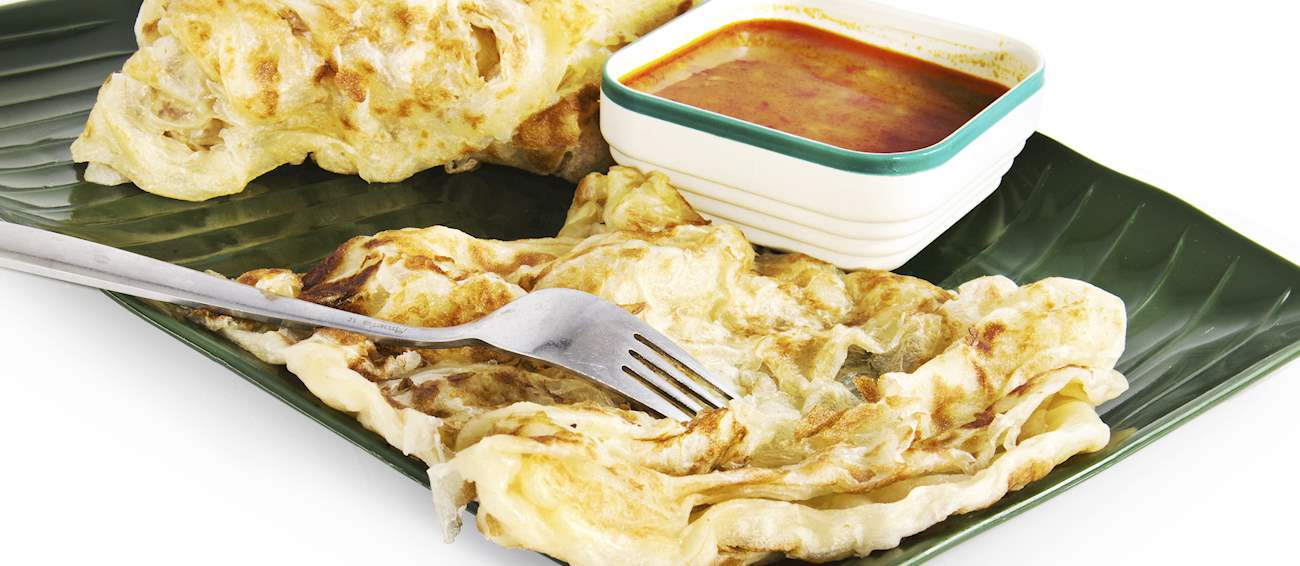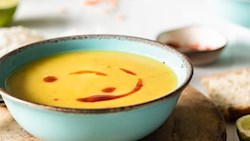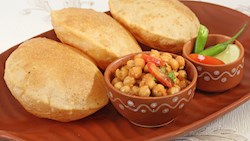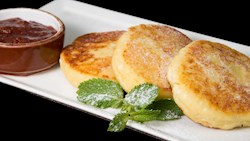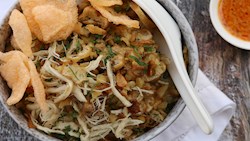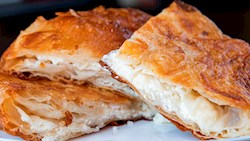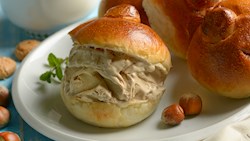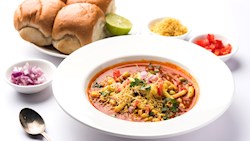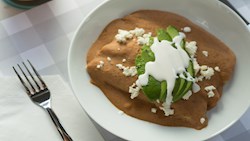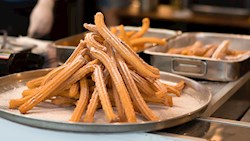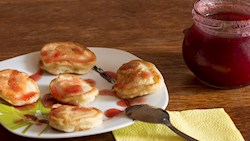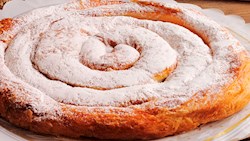Kahvaltı refers to breakfast in Turkish, and it's an essential and often lavish meal in Turkish culture. The word "kahvaltı" is derived from two words: "kahve" (coffee) and "altı" (under/before), which translates to "before coffee." It's a meal that traditionally happens before coffee is consumed, as in the Ottoman times, coffee was considered a beverage to be enjoyed after meals rather than during or before them.
Traditional Turkish kahvaltı showcases an expansive array of dishes, typically blending a multitude of flavors, textures, and food categories. The table is adorned with both sweet and savory items, spanning cheeses, olives, vegetables, local breads, eggs, börek, baklava or other sweet pastries, and more, accompanied by hot beverages such as Turkish tea (çay).
MAIN INGREDIENTS
Roti canai is a traditional pan-fried flatbread made with flour, water, eggs, and fat of Indian origin, but mainly associated with Malaysia, and surrounding countries like Indonesia, Brunei, and Thailand. The dough for roti canai is repeatedly folded, so the final product has a layered texture, a soft interior, and a crispy outer layer.
The most common fat used in roti canai is ghee, the traditional Indian clarified butter. It is believed that the dish originated in India when the Indian laborers who migrated to Malaysia brought the recipe and the tradition of preparing this crispy pastry to the foreign country.
VARIATIONS OF Roti canai
MOST ICONIC Roti canai
View moreThis delicacy consists of a traditional flatbread (lepinja) that is cut in half, coated in thick cream (kajmak), and topped with an egg. The combination is shortly baked and should be doused with a mixture of warm meat drippings, which is locally known as pretop.
Komplet can be loosely translated as with everything in it, and is traditionally associated with Užice and Zlatibor. It is believed to have originated sometime before WWII, and the name was officially registered by Dragan Lazić, a current owner of the bakery Kod Šuljage in Užice.
Sfinz is a traditional fried pastry made with a dough consisting of flour, sugar, yeast, salt, and water. The dough is shaped into small balls which are then flattened to form a thin layer of pastry. After it has been fried, sfinz is typically enjoyed with honey, although it can also be fried with an egg on top.
Also known as Libyan doughnut, this fried pastry is especially popular for breaking the fast during Ramadan, but it can also be served for breakfast. If there is any leftover dough, Libyans usually transform it into herb bread.
MAIN INGREDIENTS
Kaleh pacheh is a traditional Persian dish made from various parts of a sheep’s head and feet, typically enjoyed as a hearty breakfast in Iran and other parts of the Middle East and Central Asia. The dish's name reflects its ingredients, with "kaleh" meaning head and "pacheh" meaning feet.
The preparation involves slow-cooking the sheep’s head, feet, and sometimes the stomach with onions, turmeric, garlic, and various spices until they become tender and gelatinous. Kaleh pacheh is known for its rich, fatty broth and its distinct texture, offering a unique taste that is savory, intense, and slightly gelatinous.
These flaky, golden-colored, crescent-shaped pastries are best made with pure butter and a slightly sweet yeast dough. If made properly, the yellow-white interior should be just the slightest bit elastic when pulled from the center, ready to be covered with a pad of butter or some fresh jam.
Experts agree that the croissant was heavily influenced by Austrian kipfels. This pastry originated in 1683 as a celebration of the Austrian victory over the Ottoman Empire, its shape supposedly mimicking the crescent moon found on the Turkish flag.
MOST ICONIC Croissant
View moreA favorite breakfast item in China sold by numerous street food vendors early in the morning, jianbing or fried pancake is a thin and savory crêpe-like pancake that is made by spreading batter over a hot, cast-iron slab with a wooden paddle.
The batter can be made with a variety of different flour, with the most common types being mung bean flour, black bean flour, and wheat flour. Always freshly prepared and warm, this fried pancake is usually topped with eggs, then flavored with various sauces such as chili sauce, hoisin sauce, or tianmianjiang (savory bean paste) sauce, and filled with ingredients such as spring onions, mustard pickles, radishes, scallions, cilantro, or even a protein such as Chinese sausage or chicken.
MAIN INGREDIENTS
Literally translated to cheese bread, pão de queijo has its origins in the culinary inventions of African slaves, when they started to use the residue of the cassava plant. A fine white powder, or starch, was rolled into balls and baked.
At the time, no cheese was added, so it was just baked starch, but at the end of the 19th century, when slavery ended, other foods started to become available to the Afro-Brazilians for the first time. In the state of Minas Gerais, the dairy center of Brazil, cheese and milk started to be added to the starchy balls, and pão de queijo was created.
MOST ICONIC Pão de queijo
View moreMAIN INGREDIENTS
A type of sweet börek, katmer is a specialty of Gaziantep, or simply Antep – Türkiye's gastronomic capital and a rich melting pot of diverse cultures and cuisines nestled in southeastern Anatolia – an ancient city whose claim to fame is being home to world’s finest pistachios and the delicious Antep baklavası.
Katmer is what most locals start their day with: in fact, there are bakeries and cafés in Gaziantep open from early morning until noon serving katmer for breakfast. Traditionally, it is also the first meal eaten by newlyweds after their first wedding night, as it represents the sweetness they hope to find in their marriage.
MOST ICONIC Katmer
View moreMAIN INGREDIENTS
Bougatsa is a traditional, rustic Greek pie consisting of a phyllo pastry layered with a filling of semolina custard, although there are variations with minced meat or cheese. The name of the dish is a derivation of the Ottoman word pogatsa, denoting a pie filled with cheese.
Bougatsa has origins from the Byzantine period, when Constantinople was Greek, and it began as a dough that was stuffed with numerous sweet and savory fillings. Over time, bougatsa evolved to incorporate a thinly rolled, hand-made phyllo pastry. As many Turkish immigrants settled in Northen Greece, bougatsa became a specialty of Serres and Thessaloniki.
MOST ICONIC Bougatsa
View moreTasteAtlas food rankings are based on the ratings of the TasteAtlas audience, with a series of mechanisms that recognize real users and that ignore bot, nationalist or local patriotic ratings, and give additional value to the ratings of users that the system recognizes as knowledgeable. For the “Top 100 Breakfasts in the World” list until February 13, 2025, 39,805 ratings were recorded, of which 23,012 were recognized by the system as legitimate. TasteAtlas Rankings should not be seen as the final global conclusion about food. Their purpose is to promote excellent local foods, instill pride in traditional dishes, and arouse curiosity about dishes you haven’t tried.
